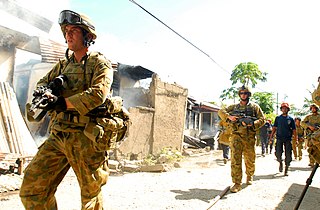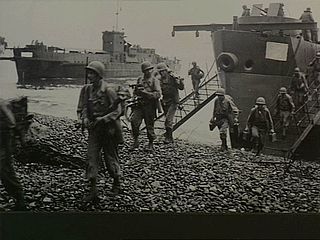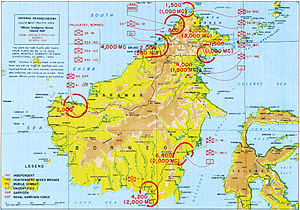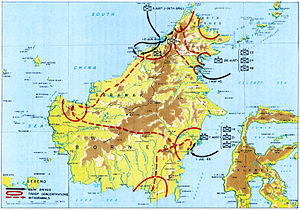
Iron Range is a National Park located in Queensland, Australia, 1,940 km northwest of Brisbane and 100 km east of Weipa in the Cape York Peninsula, Queensland. Within the National Park is the Iron Range, Scrubby Creek mining site and the Lockhart River Aboriginal Reserve. During World War II several Australian Army units were stationed in the area.
Operation Husky Order of Battle is a listing of the significant military and air force units that were involved in the campaign for Sicily, July 10 – August 17, 1943.

The Philippines Campaign or the Battle of the Philippines, fought 8 December 1941 – 8 May 1942, was the invasion of the Philippines by Imperial Japan and the defense of the islands by United States and Filipino forces during the Second World War.

RAAF Base Darwin is a Royal Australian Air Force (RAAF) military air base located in the city of Darwin, in the Northern Territory, Australia. The base shares its runway with Darwin International Airport, for civil aviation purposes. The heritage-listed RAAF Base Darwin is a forward operating base with year-round activity with approximately 400 personnel.

The Battle of Balikpapan was the concluding stage of Operation Oboe. The landings took place on 1 July 1945. The Australian 7th Division, composed of the 18th, 21st and 25th Infantry Brigades, with KNIL troops, made an amphibious landing, codenamed Operation Oboe Two a few miles north of Balikpapan, on the island of Borneo. The landing had been preceded by heavy bombing and shelling by Australian and US air and naval forces. The Japanese were outnumbered and outgunned, but like the other battles of the Pacific War, many of them fought to the death.

Operation Chronicle was the Allied invasion of Woodlark and Kiriwina Islands during World War II, in the South West Pacific as part of Operation Cartwheel. An early planning name for this operation was Operation Coronet. The operation was executed without opposition on 30 June 1943.

Operation Astute was an Australian-led military deployment to East Timor to quell unrest and return stability in the 2006 East Timor crisis. It was headed by Brigadier Bill Sowry, and commenced on 25 May 2006 under the command of Brigadier Michael Slater. The operation was established at the request of East Timor's government, and continues under an understanding reached between Australia, East Timor, and the United Nations, with the United Nations Integrated Mission in East Timor supporting and helping to develop East Timor's police force. Other countries deploying soldiers to East Timor include Malaysia, New Zealand and East Timor's former colonial power Portugal, operating under independent command.
The British Commonwealth Far East Strategic Reserve was a joint military force of the British, Australian, and New Zealand armed forces. Created in the 1950s and based in Malaya, the FESR was conceived as a forward defence point for Australia and New Zealand, while protecting Commonwealth interests in the Southeast Asian region from both internal and external communist threats. The FESR was made up of an infantry brigade and a carrier group, supported by squadrons of aircraft.
This is the order of battle for the Japanese invasion of French Indochina during World War II.

The Battle of Labuan was an engagement fought between Allied and Imperial Japanese forces on the island of Labuan off Borneo during June 1945. It formed part of the Australian invasion of North Borneo, and was initiated by the Allied forces as part of a plan to capture the Brunei Bay area and develop it into a base to support future offensives.
The Gloucester Cup is the common name for three awards of the Australian Defence Force. Formally referred to as the Duke of Gloucester Cup, the three awards are presented to the most efficient infantry battalion of the Australian Army, ship of the Royal Australian Navy (RAN), and squadron of the Royal Australian Air Force (RAAF) during the previous year. The awards were created by Prince Henry, Duke of Gloucester in 1946, while he was serving as the Governor-General of Australia, and were first presented in 1947.

This is the order of battle of Allied and Japanese forces during the Landing at Saidor in 1944.

Mareeba Airfield is an airfield located 4.3 nautical miles south of Mareeba, Queensland, Australia. Built in 1942 as a US Army Air Force base during World War II, the airfield had two runways, with a complement of taxiways, hardstands and a containment area. After the war, much of the airfield reverted to agricultural use, while the southern runway remains as an active airfield.

The order of battle of Australian forces during the Korean War consisted of one, and later two infantry battalions, naval forces of one aircraft carrier, two destroyers, and one frigate, as well as air forces consisting of one fighter squadron and one transport squadron. The first forces were committed in July 1950 from units based in Japan as part of the British Commonwealth Occupation Force, with Australia being the first UN member nation after the United States to commit elements from all three services. A total of 17,808 Australians served during the Korean War, including 1,193 members of the Royal Australian Air Force (RAAF), 5,771 from the Royal Australian Navy (RAN), and 10,844 from the Australian Army, with casualties including 341 killed and 1,216 wounded. Australian forces remained following the end of hostilities, with the last units finally departing in 1956.
This is the order of battle of Allied and German forces during Operation Dragoon in 1944.

This is an order of battle listing the Allied and Japanese forces involved in the Battle of Arawe from 15 December 1943 to 24 February 1944.

This is an order of battle listing the Japanese and Allied forces involved in the Battle of Milne Bay from 25 August – 7 September 1942.
This is an order of battle listing the British and Commonwealth forces involved in the Indonesia-Malaysia confrontation (1962–66).

The order of battle of Australian forces during the Vietnam War consisted of a small group of military advisors from 1962, but grew to include an infantry battalion based in Bien Hoa in 1965. This force was then replaced by a two- and later three-battalion task force with supporting arms based at Nui Dat which operated primarily in Phuoc Tuy Province between 1966–71, with logistic elements at Vung Tau. Airforce units committed initially consisted of transport aircraft, but were followed by helicopters and later bombers, while naval forces included destroyers and transport vessels. With the size of Australian forces in Vietnam reaching a peak in early 1968, a drawdown commenced in late 1970, with the bulk withdrawn by early 1972. The last elements returned to Australia in 1973. In total, around 50,000 Australians served during the Vietnam War, including 42,437 members of the Australian Army, 3,310 from the Royal Australian Navy (RAN), and 4,443 from the Royal Australian Air Force (RAAF), with casualties including 519 killed and 2,348 wounded.





















